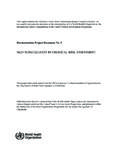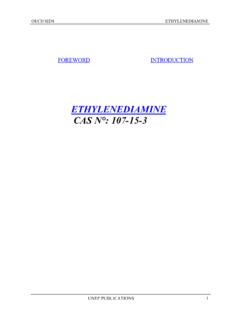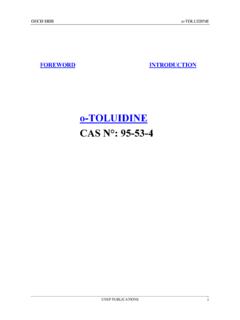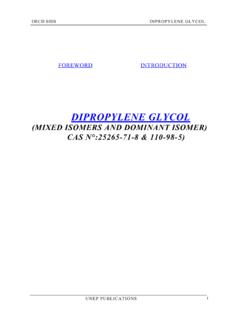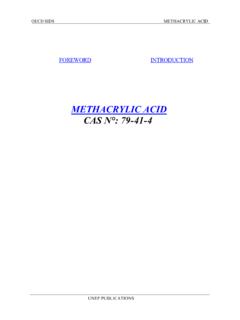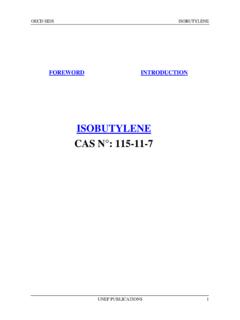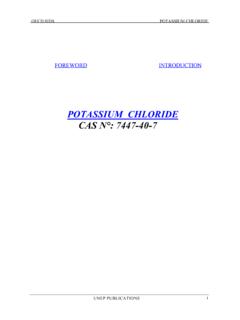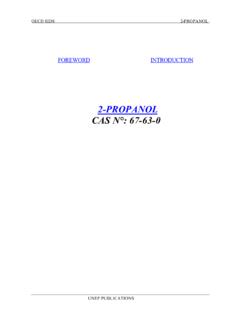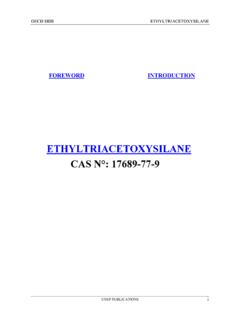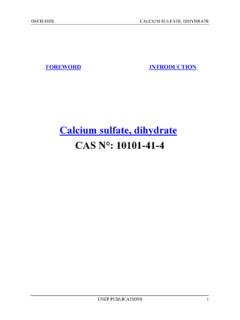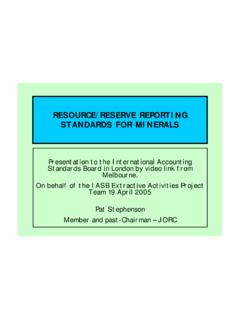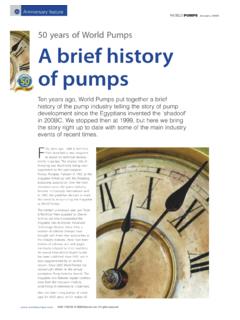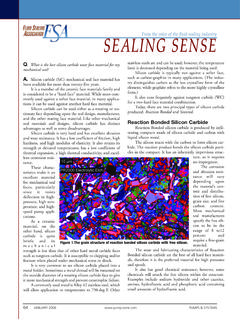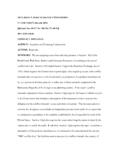Transcription of TUNGSTEN CARBIDE CAS N°: 12070-12-1 - …
1 OECD SIDS TUNGSTEN CARBIDE UNEP PUBLICATIONS 1 FOREWORD INTRODUCTION TUNGSTEN CARBIDE CAS N : 12070-12-1 OECD SIDS TUNGSTEN CARBIDE UNEP PUBLICATIONS 2 SIDS Initial Assessment Report For SIAM 21 Washington, DC, 18-20 October 2005 1. Chemical Name: TUNGSTEN CARBIDE 2. CAS Number: 12070-12-1 3.
2 Sponsor Country: Germany Contact Point: BMU (Bundesministerium fuer Umwelt, Naturschutz und Reaktorsicherheit) Contact person: Prof. Dr. Ulrich Schlottmann Postfach 12 06 29 D- 53048 Bonn 4. Shared Partnership with: - 5. Roles/Responsibilities of the Partners: - Name of industry sponsor /consortium H. C. Starck GmbH, D-38642 Goslar Bayer AG, Germany, D-51368 Leverkusen Contact person: Dr. Burkhardt Stock D-51368 Leverkusen Building 9115 Process used The BUA Peer Review Process: see next page 6. Sponsorship History How was the chemical or category brought into the SIDS Program? by ICCA-Initiative 7. Review Process Prior to the SIAM: last literature search (update): 31 Mai 2005 (Human Health): databases medline, toxline; search profile CAS-No. and special search terms 9 May 2005 (Ecotoxicology): databases CA, biosis; search profile CAS-No.
3 And special search terms OECD/ICCA 8. Quality check process: IUCLID was used as a basis for the SIDS dossier. All data were checked and validated by BUA. A final evaluation of the human health part has been performed by the Federal Institute for Risk Assessment (BfR) and of the ecotoxicological part by the Federal Environment Agency (UBA). 9. Date of Submission: Deadline for circulation: July 22, 2005 10. Date of last Update: Last literature search: IUCLID Chapter 1: 2005-03-01, Chapters 2-4: 2003-10-01, Chapter 5: 2005-01-01 OECD SIDS TUNGSTEN CARBIDE UNEP PUBLICATIONS 311.
4 Comments: OECD/ICCA - The BUA* Peer Review Process Qualified BUA personnel (toxicologists, ecotoxicologists) perform a quality control on the full SIDS dossier submitted by industry. This quality control process follows internal BUA guidelines/instructions for the OECD/ICCA peer review process and includes: - a full (or update) literature search to verify completeness of data provided by industry in the IUCLID/HEDSET - Review of data and assessment of the quality of data - Review of data evaluation - Check of adequacy of selection process for key studies for OECD endpoints, and, where relevant, for non-OECD endpoints by checking original reports/publications - Review of key study description according robust summaries requirements.
5 Completeness and correctness is checked against original reports/publications (if original reports are missing: reliability (4), reliability not assignable) - Review o f validity of structure-activity relationships - Review of full SIDS dossier (including SIAR, SIAP and proposal for conclusion and recommendation for further work) - In case of data gaps, review of testing plan or rationale for not testing * BUA (GDCh-Beratergremium f r Altstoffe): Advisory Committee on Existing Chemicals of the Association of German Chemists (GDCh) OECD SIDS TUNGSTEN CARBIDE UNEP PUBLICATIONS 4 SIDS Initial Assessment Report 1 IDENTITY Identification of the Substance CAS Number: 12070-12-1 IUPAC Name: TUNGSTEN CARBIDE Molecular Formula: WC Structural Formula: WC Molecular Weight: g/mol Synonyms: TUNGSTEN monocarbide - TUNGSTEN CARBIDE Several phases of the binary system W-C have been described in literature (Gmelin, 1993).
6 Of major importance is - TUNGSTEN CARBIDE (WC) which forms homogeneously only when TUNGSTEN and carbon are present in a nearly exact stoichiometric ratio of mol % C (Tulhoff, 2000). Purity/Impurities/Additives For TUNGSTEN CARBIDE of the grade HC the following elemental composition is reported (% w/w) (H. C. Starck, 2003): TUNGSTEN > 93 Carbon Iron < OECD SIDS TUNGSTEN CARBIDE UNEP PUBLICATIONS Physico-Chemical properties Table 1 Summary of physico-chemical properties of TUNGSTEN CARBIDE Property Value Reference IUCLID Substance type Inorganic compound H.
7 C. Starck, 2003 Physical state Grey metallic powder H. C. Starck, 2003 Melting point 2776 C Tulhoff, 2000 Boiling point at 1013 hPa 6000 C Lide, 1991 Density g/cm3 at 18 C Lide, 1991 Vapor pressure Not determinable* H. C. Starck, 2004 Partition coefficient n-octanol/water (log Kow) Not calculable Bayer Industry Services, 2005 Water solubility < mg/l at 20 C Cassella Aktiengesellschaft, 1995 Flash point Non-inflammable H. C. Starck, 2005 Auto flammability (ignition temperature) Inflammable at > 300 C H. C. Starck, 2005 *Based on the boiling point, the vapor pressure is expected to be extremely low 2 GENERAL INFORMATION ON EXPOSURE Production Volumes and Use Pattern TUNGSTEN CARBIDE is manufactured by direct carburization of TUNGSTEN with carbon (Roempp, 2003).
8 Mixtures of metal and carbon black or graphite are heated at a temperature of 1400 - 2000 C in vacuum or under hydrogen (Tulhoff, 2000): W + C WC. When heating a mixture of TUNGSTEN and carbon in a carbon tube or high-frequency furnace to ca. 2800 C, cast TUNGSTEN CARBIDE is obtained (Gmelin, 1993). However, most TUNGSTEN CARBIDE is sold as powders with distinct ranges of grain sizes (Tulhoff, 2000). Purity and grain size determine the physical properties and the technical applicability of TUNGSTEN CARBIDE . Since milling changes the chemical composition and the shape of the grains, coarse powders of TUNGSTEN CARBIDE can not be milled to obtain fine-grained powders. Instead, to obtain the desired industrial product, the particle size of the raw materials is carefully selected.
9 The grain size of the product is also influenced by manufacturing parameters like temperature, reaction time, presence of humidity and hydrogen. Typical production lines start from TUNGSTEN ore (W, Nb, Fe-oxides), TUNGSTEN scrap, scheelite (CaWO4), tungstic acid (H2WO4), and ammonium paratungstate ((NH4)10W12O41 x 5 H2O). Typical intermediates are yellow (WO3), blue (approximately W4O11), and brown TUNGSTEN oxide (WO2). There are several methods for the manufacturing of the technical TUNGSTEN CARBIDE powders (Tulhoff, 2000): Tungstic acid powder is reduced to TUNGSTEN by hydrogen OECD SIDS TUNGSTEN CARBIDE UNEP PUBLICATIONS 6at 750 C.
10 The metal particles are carburized at 1400 C. This method is applied for fine powders with an average grain size of 1 m. H2WO4 + 3 H2 W + 4 H2O W + C WC. Ammonium paratungstate can be converted to the blue TUNGSTEN oxide at 700 C in a nitrogen stream. Reduction at 800 C and carburization at 1400 C yields powders 2 - 5 m grain size. (NH4)10W12O41 x 5 H2O 3 W4O11 + 10 NH3 + 10 H2O Ammonium paratungstate can also be roasted in air to yield yellow TUNGSTEN oxide, which is reduced by wet hydrogen at 950 C and carburized at 1600 C to yield TUNGSTEN CARBIDE with a particle size of 10-20 m. (NH4)10W12O41 x 5 H2O 12 WO3 + 10 NH3 + 10 H2O TUNGSTEN oxides, tungstic acid, ammonium paratungstate, and scheelite can also be carburized directly: WO3 + 4 C WC + 3 CO H2WO4 + 4 C WC + 3 CO + H2O (NH4)10W12O41 x 5 H2O + 48 C 12 WC + 10 NH3 + 10 H2O + 36 CO CaWO4 + 4 C WC + CaO + 3 CO.
